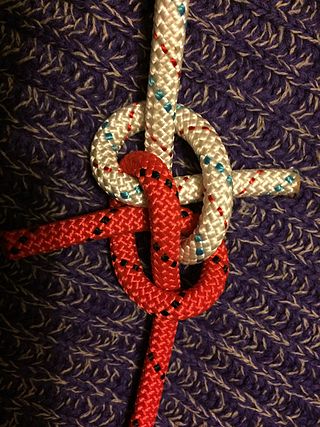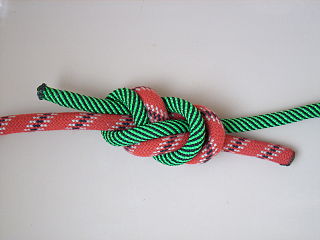
The figure-eight knot or figure-of-eight knot is a type of stopper knot. It is very important in both sailing and rock climbing as a method of stopping ropes from running out of retaining devices. Like the overhand knot, which will jam under strain, often requiring the rope to be cut, the figure-eight will also jam, but is usually more easily undone than the overhand knot.
The figure-eight or figure-of-eight knot is also called the Flemish knot. The name figure-of-eight knot appears in Lever's Sheet Anchor; or, a Key to Rigging. The word "of" is nowadays usually omitted. The knot is the sailor's common single-strand stopper knot and is tied in the ends of tackle falls and running rigging, unless the latter is fitted with monkey's tails. It is used about ship wherever a temporary stopper knot is required. The figure-eight is much easier to untie than the overhand, it does not have the same tendency to jam and so injure the fiber, and is larger, stronger, and equally secure.

A bend is a type of knot used to join two lengths of rope. Bends are used in a variety of situations, including climbing, sailing, and securing loads. They are classified based on their ability to be tightened or released, their resistance to slipping, and their strength. Some common types include the sheet bend, the double fisherman's knot, and the double figure-eight bend. Bends allow two ropes to be securely joined together, enabling the combined ropes to support weight or transmit force. It is important to choose the appropriate bend for the specific task at hand, as some may be stronger or more secure than others.

A zeppelin bend is an end-to-end joining knot formed by two symmetrically interlinked overhand knots. It is stable, secure, and highly resistant to jamming. It is also resistant to the effects of slack shaking and cyclic loading.

The heaving line bend is a knot for securely joining two ropes of different diameter or rigidity. It is often used to affix playing strings to the thick silk eyes of an anchorage knot in some stringed instruments. In nautical use, the heaving line bend is used to connect a lighter messenger line to a hawser when mooring ships. It is knot number 1463 in The Ashley Book of Knots, and appeared in the 1916 Swedish knot manual Om Knutar.

In sailing, a halyard or halliard is a line (rope) that is used to hoist a ladder, sail, flag or yard. The term "halyard" derives from the Middle English halier, with the last syllable altered by association with the English unit of measure "yard". Halyards, like most other parts of the running rigging, were classically made of natural fibre like manila or hemp.

A rope is a group of yarns, plies, fibres, or strands that are twisted or braided together into a larger and stronger form. Ropes have tensile strength and so can be used for dragging and lifting. Rope is thicker and stronger than similarly constructed cord, string, and twine.

The sheet bend is a bend knot. It is practical for joining lines of different diameter or rigidity.

A stopper knot is a knot that creates a fixed thicker point on an otherwise-uniform thickness rope for the purpose of preventing the rope, at that point, from slipping through a narrow passage, such as a hole in a block. To pass a rope through a block, or hole, is to reeve it. To pull it out is to unreeve it. Stopper knots prevent the rope from unreeving on its own.

A becket hitch, including the double becket or figure-of-eight becket hitch, is any hitch that is made on an eye loop, i.e. on a becket. A becket hitch has the same structure as the sheet bend, which joins, or "bends", the ends of two ropes together. The becket hitch, in contrast, fixes a rope to a closed eye or hook. In this instance, a becket means the eye or hook of a pulley block, an eye in the end of a rope, or a rope handle on a sailor's sea chest.

The offset overhand bend is a knot used to join two ropes together end-to-end. It is formed by holding two rope ends next to each other and tying an overhand knot in them as if they were a single line. Due to its common use in several fields, this bend has become known by many names, such as thumb knot, openhand knot, one-sided overhand knot or flat overhand bend (FOB), though the terms "one-sided" and "flat" are considered incorrect.

The Albright special or Albright knot is a bend used in angling. It is a strong knot used to tie two different diameters of line together, for instance to tie monofilament to braid. The Albright is relatively smooth and passes through guides when required. Some anglers coat the knot with a rubber based cement to make it even smoother and more secure.

The Flemish bend, also known as a figure eight bend, a rewoven figure eight is a knot for joining two ropes of roughly similar size.

The name single carrick bend has been used and even recommended by many different people to refer to different knots with a similar general form to the carrick bend. All of these knots are weaker and less secure for the purpose of a bend which is the connection of two rope ends. Several have other properties which make them desirable for specific uses.

The simple Simon under bend is a knot belonging to the category bend. It was invented by Harry Asher. It is more secure than the similar Simple Simon over and more effective with quite large differences in thickness of the two ropes.

The harness knot is a general purpose bend knot used to join two ropes together. The knot can be tied under tension and will not capsize.

The reef knot, or square knot, is an ancient and simple binding knot used to secure a rope or line around an object. It is sometimes also referred to as a Hercules knot. The knot is formed by tying a left-handed overhand knot between two ends, instead of around one end, and then a right-handed overhand knot via the same procedure, or vice versa. A common mnemonic for this procedure is "right over left; left over right", which is often appended with the rhyming suffix "... makes a knot both tidy and tight". Two consecutive overhands tied as described above of the same handedness will make a granny knot. The working ends of the reef knot must emerge both at the top or both at the bottom, otherwise a thief knot results.
The reef knot or square knot consists of two half knots, one left and one right, one being tied on top of the other, and either being tied first...The reef knot is unique in that it may be tied and tightened with both ends. It is universally used for parcels, rolls and bundles. At sea it is always employed in reefing and furling sails and stopping clothes for drying. But under no circumstances should it ever be tied as a bend, for if tied with two ends of unequal size, or if one end is stiffer or smoother than the other, the knot is almost bound to spill. Except for its true purpose of binding it is a knot to be shunned.

A heaving line knot is a family of knots which are used for adding weight to the end of a rope, to make the rope easier to throw. In nautical use, a heaving line knot is often tied to the end of a messenger line, which is then used for pulling a larger rope, such as a hawser. There are several distinct knots which all share the common name, heaving line knot. The monkey fist is a well-known heaving line knot.

















